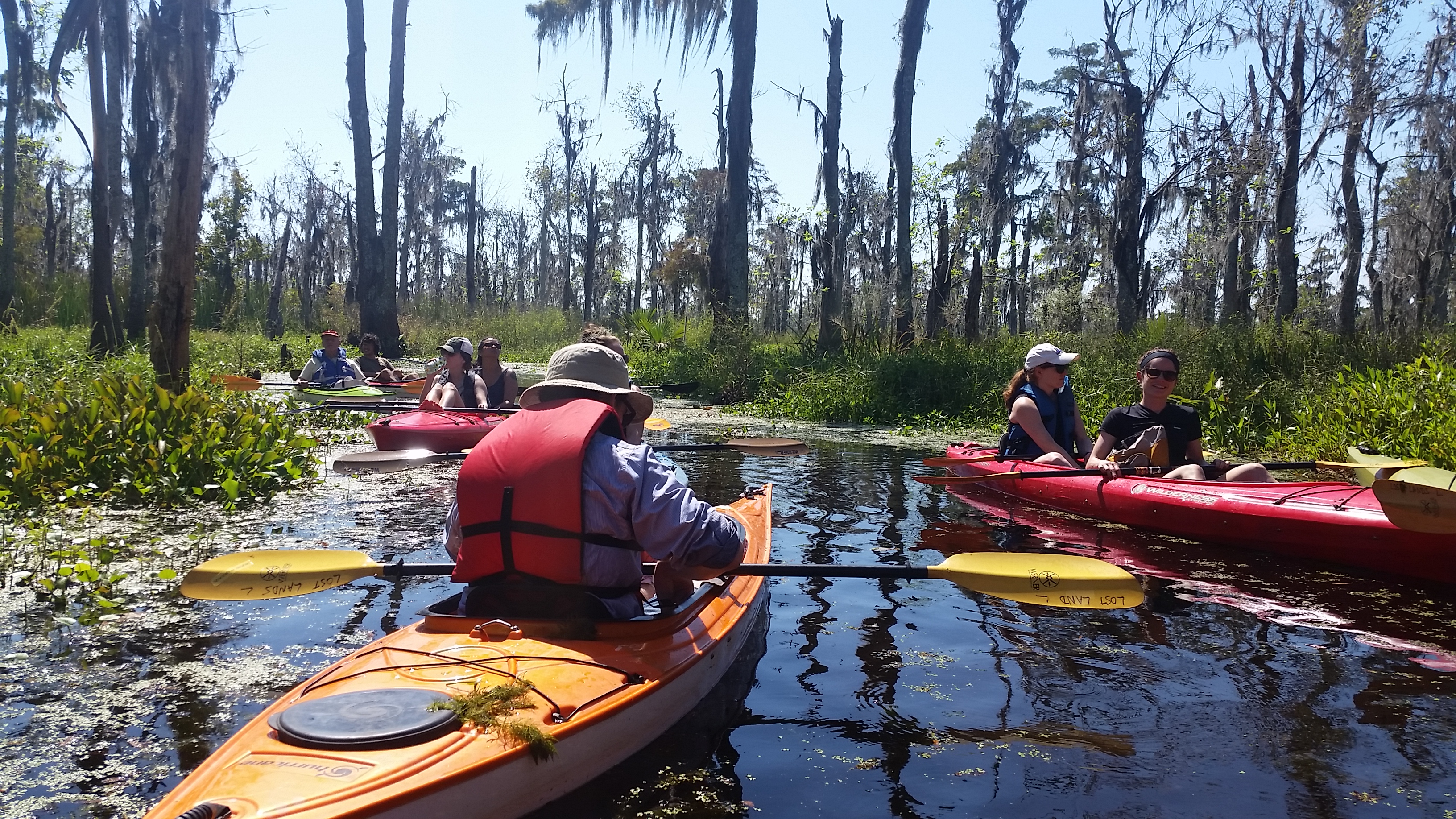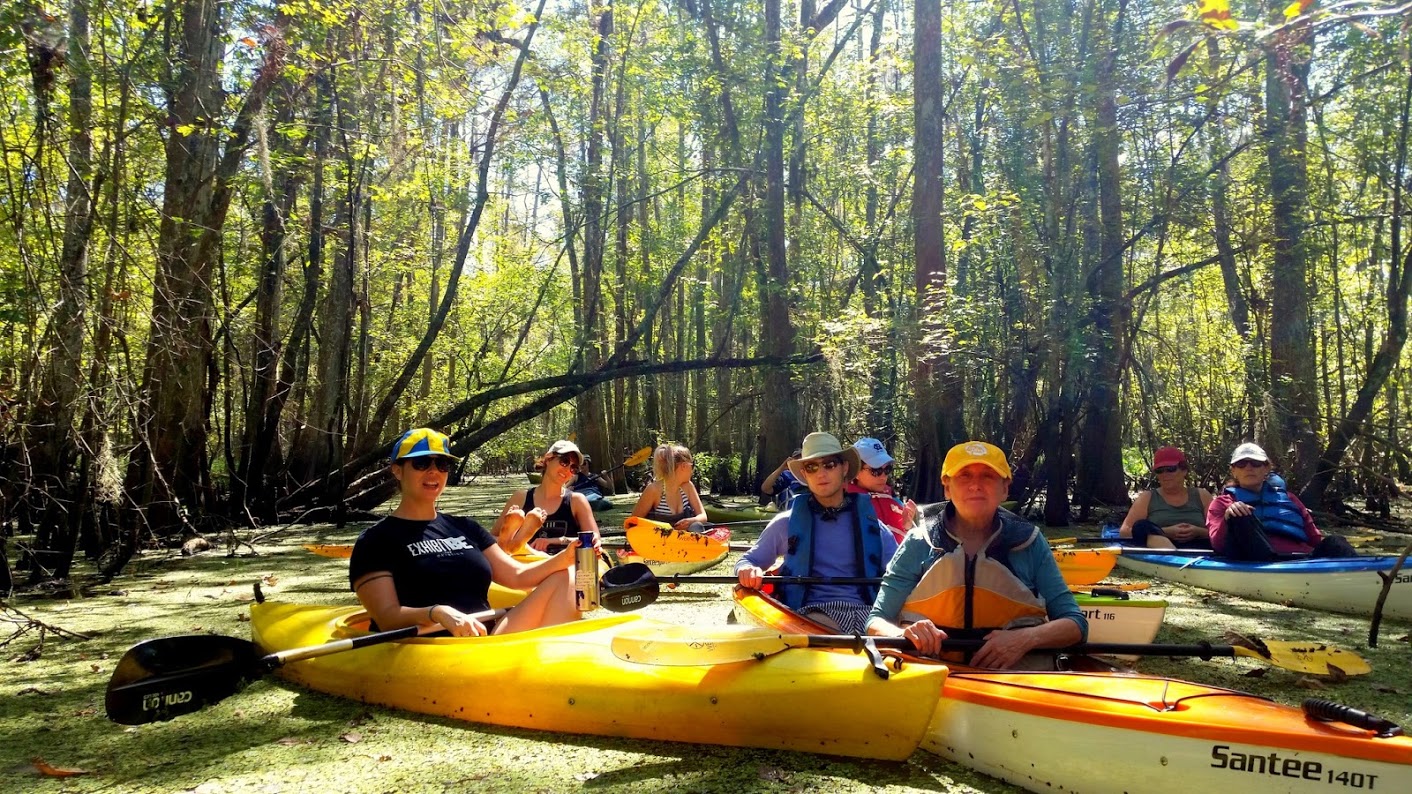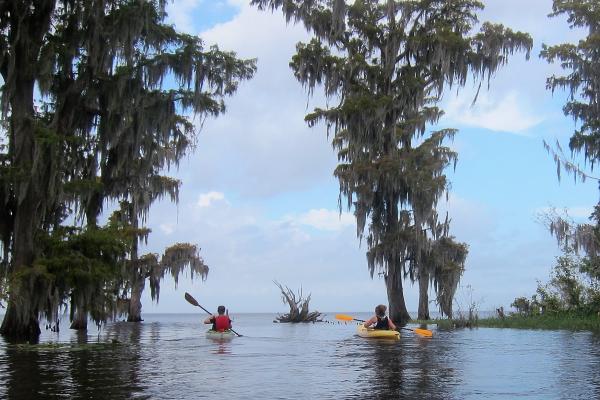Take a swarm of mosquitoes in a south Louisiana bayou, add a bit of humidity and a dose of humanity in slow moving kayaks to arrive—figuratively speaking—at the production of philosophical prose. The journey down the bayou is real, and is the idea of University of New Orleans English professor Richard Goodman.
The day trip is part of a writing assignment for students in Goodman’s creative nonfiction Master of Fine Arts workshop. It is an exercise in ecological awareness intended to stretch writers’ imaginations by requiring them to produce a reflective essay on their experience.
“In nonfiction a lot of the students write about themselves, memoirs,” Goodman said. “I’m alright with that, but I would like for them to learn to write about other things because you can’t make a career out of writing just about yourself.”
The annual coastal excursion provides context and substance that help students to explore themes beyond themselves, Goodman said. The resulting essays have taken a variety of perspectives and many forms, including one graphic artist telling her story via illustrations, he said.
 “So when you’re exposed to new, you just refresh your brain. You reboot your brain in a way,” Goodman said. “Also a lot of times if they do write about themselves, it’s reflected through this environment.”
“So when you’re exposed to new, you just refresh your brain. You reboot your brain in a way,” Goodman said. “Also a lot of times if they do write about themselves, it’s reflected through this environment.”
Those writing assignments, which Goodman posted on a website designed for writers, recently caught the attention of editors at ViaNolaVie, a New Orleans-based website that focuses on Louisiana culture.
They liked what they were reading.
“ViaNolaVie spotlights the eclectic and unique arts, culture, and educational landscape in Louisiana and, wouldn't you know it, the writers in Richard Goodman's MFA writing workshop are writing about most, if not all, of these life forces in their reflections on their time down the bayou,” said Kelley Crawford, managing editor at ViaNolaVie.
ViaNolaVie asked for permission to include all of the student essays from past and future trips in their publication, offering the chance for many of Goodman’s students their first professional byline.
The first of the down the bayou trip stories appeared in September, and will publish weekly every Wednesday.
“I think a lot of them are excited about it,” Goodman said. “When you’re a student so many times you just want to get published.”
 Crawford commends Goodman’s workshop for providing students with an artistic outlet and for sharing information on some of Louisiana’s unique landscapes.
Crawford commends Goodman’s workshop for providing students with an artistic outlet and for sharing information on some of Louisiana’s unique landscapes.
“Goodman's workshop offers writers a space to create their individual art while also reflecting on either their personal culture or the culture of what surrounds them,” Crawford said, “and of course there is the pedagogical connection to not only make the assignment engaging but also a public good. People can now vicariously kayak down the bayou with these writers, and we have an archive of what the bayou was like on that given day.“
Goodman isn’t quite sure where the idea for the group kayak day trip came from three years ago, only that a former colleague had taken him out once and he’d enjoyed the trip immensely.
Goodman hires an environmental tour guide who leads the group of writers, typically eight to 10 of them, through a coastal Louisiana waterway via kayaks. Previous trips have been along the Blind River and Lake Maurepas in St. James Parish and Shell Bank Bayou in St. John the Baptist Parish, both spots about an hour west of New Orleans.
In its fourth year, Goodman said students have yet to balk at the idea of a day spent on an isolated bayou. The trip is on a weekend, typically in late October or early November.
“I introduce this the first day of the workshop,” Goodman said. “Every single time everyone has wanted to do it.”
Goodman said he crowdfunds the expense of renting kayaks and hiring a guide from Lost Lands Environmental Tours, a company co-owned by Marie Gould and her husband environmental reporter Bob Marshall, who is the former outdoors editor for The Times-Picayune.
Prior to the students heading into the bayou, Marshall gives them about an hour-long talk on the precarious state of Louisiana’s coastal wetlands and the importance of coastal restoration.
“Once on the bayou, the guide will explain a few things along the way, but a lot of it is really them just taking it all in,” Goodman said. “A lot of the students don’t know what a bayou is, or they’ve never been on a bayou and sometimes never been in a kayak.”
It’s not unusual for the group to see alligators, egrets, woodpeckers, owls, and to have to contend with annoying insects and clingy hyacinth that tangles up many a paddle. In fact, during one trip, the vegetation was so thick that the kayaks had an extremely difficult time paddling through, Goodman recalled.
“We got stuck in that and it was sort of a hard day, and so I say, ‘This is a great metaphor for life—adversity! Use it!’” Goodman said with a laugh. “And so they did.”





